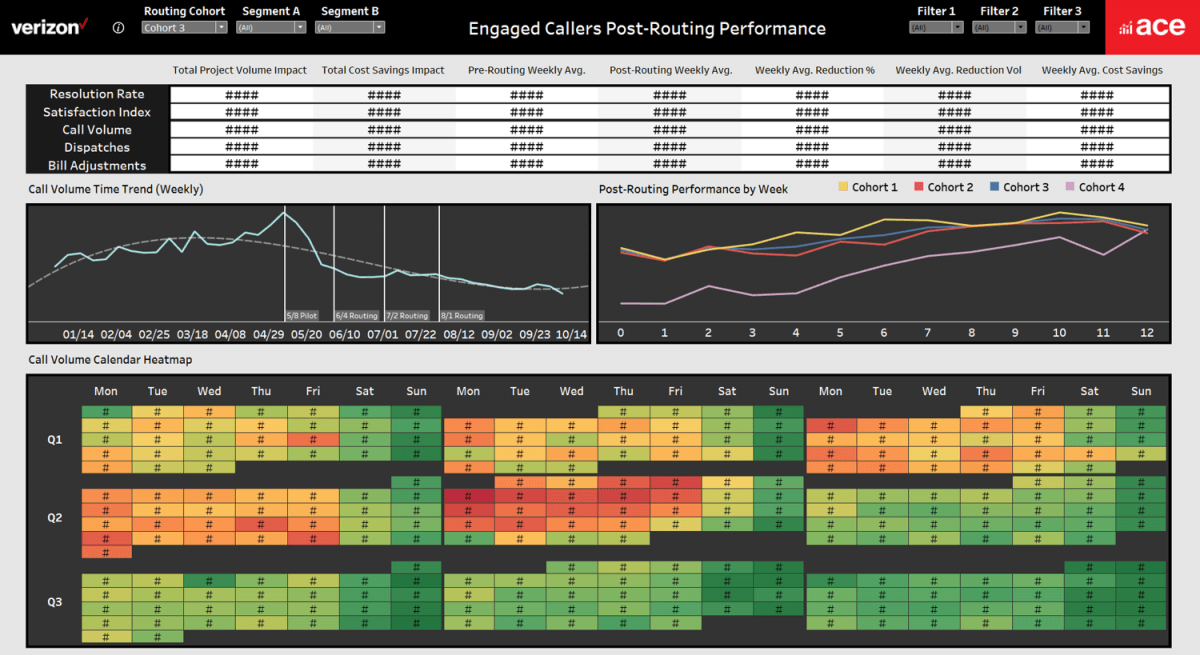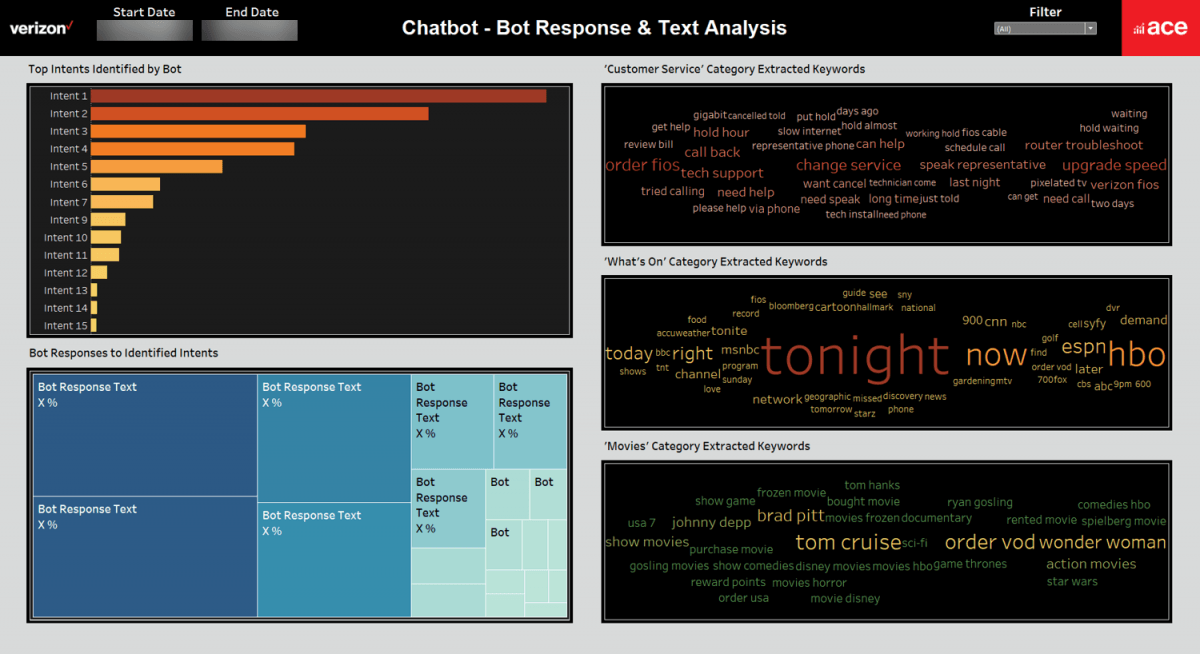
Verizon uses Tableau to reduce support calls by 43%, enhancing customer experience
Cut customer service analysis time by 50% across call centre, digital and dispatch teams
Reduced call volume by 43% and tech dispatches by 62% for certain cohorts of customers
Created 1,500+ dashboards ingesting billions of rows of data from Hadoop, Teradata and Oracle
Verizon Fios offers residential connectivity solutions including broadband Internet, landline voice and cable TV service delivered over fibre optics to millions of customers. These services include 6.9 million broadband connections, 4.5 million TV subscribers and 12.2 million landline phone users – resulting in multiple data sources with billions of rows of data generated (up to 4 terabytes a day), to be managed by the Analytics Centre of Excellence team. Put in perspective, that’s nearly half of the US Library of Congress’ collection, totalling 10 terabytes.
Verizon’s Analytics Centre of Excellence (ACE), a team of more than 80 people, used data science and advanced analytics in the company’s digital, call centre, dispatch, marketing and finance functions to optimise operations and enhance customer experience. They took online and offline data from Hadoop, Teradata, and Oracle, extracted and reduced it to smaller datasets, and then analysed it in Tableau. This effective approach meant dashboards were in 200+ stakeholders’ hands in time for analysis. Stakeholders ranged from executives to customer-facing call centre staff, who make better decisions and deliver excellent customer service with daily insights uncovered by Tableau.
Using the platform, ACE created more than 1,500 self-serving dashboards that were consumed by operations, business transformation, product development, marketing and software engineering teams. The interactive dashboards have received 125,000-plus views, with a governed infrastructure that guarantees data is clean and usable. Tableau adoption is on the rise as Fios teams use geo-spatial mapping features to understand location-based impact and analyse text from customer chat sessions, leveraging the Tableau + R and Tableau + Mapbox integrations. These initiatives helped resolve customer service problems and improved customer satisfaction in Fios, with fewer calls and service dispatches lowering operational costs.

Analytics Centre of Excellence scales analytics process for digital and call centre operations
Verizon Fios used manual Excel tables to analyse data like digital and call centre metrics. Results were distributed to several teams in static reports. Joining data before analysis also proved tricky with multiple sources to pull from: Oracle, Hadoop and Teradata. Having limited analytics resources, but a large set of diverse stakeholders to serve, this was an inefficient process that created bottlenecks and redundancies and prevented users from easily digesting data to answer their questions. Gregory McConney, Associate Director of Contact Centre Analytics, explained how analytics staff “strive to perform advanced analytics and build predictive models and machine learning solutions that enable the business to move forward... We don’t want to create basic insights when business stakeholders can do that themselves.”
Verizon dedicated talent and attention to creating an Analytics Centre for Excellence (ACE). The 80+ person team has nearly 30 members who perform analysis in Tableau and deliver insights to key stakeholders. Other members support data governance, data prep and modelling before handing off to Tableau developers and server administrators. “The first thing we do is structure the data correctly for it to scale and be automated. We put a lot of thought on structuring the data right and building views on top that will distribute information in the most intuitive way,” explained Sid Dayama, Senior Manager of Data Analytics for Verizon.
Before building suites of dashboards, ACE held planning sessions with stakeholders to determine needs. They developed dashboards optimised for fast load times, supporting more effective discussions that transformed how they make decisions from the top down.
Once everyone began to embrace the dashboards, the team became more efficient at finding insights with features like tooltips, reflecting details within the visualisations and clarifying field definitions. They look forward to embracing other platform features and using different chart types to further strengthen the customer experience.
Tableau is so great because it talks to all this different software. And for us, this was a big milestone – tying them together and getting text mining into a dashboard.
Call centre increases capacity, improves customer routing and sentiment with 50% faster analysis time
Customers interact with Verizon’s support team in a few ways – through online chat, call centres, and cross-channel, which means starting in digital channels and ending in a call centre. However, Verizon wanted customers to self-serve digitally and avoid the call centres so they don’t have to wait for answers or a tech visit, keeping satisfaction levels high. More importantly, they didn’t want repeated call centre contact because that meant a problem was unresolved, producing lower efficiency and higher operational costs within the call centre and dispatch teams.
Understanding that different segments of customers have varying calling behaviour, ACE built an optimised routing solution for certain cohorts of customers, leveraging Tableau dashboards where teams including business transformation, analytics, IT, and call centre operations analysed customer engagement in call centres and monitored call sentiment.

The analytics team analyses 17 different attributes for each individual person in the customer base, looking at the tenure of the customer, what products they use, call drivers, how frequently they call, average handling time, call sentiment upon contact, age and many more. Customers are then categorised and put into different cohorts for treatment.
These individual cohorts are then routed to a special support queue where skilled call centre representatives handle requests to avoid repeated problems. Tableau dashboards arm the call centre reps with contextual information such as historical calling patterns of the customers they are handling so they can resolve issues effectively and reduce the need for customers to call multiple times.
The team used the alerts feature in Tableau to notify them when the call volume goes down below the conditional visual threshold. And when it does, an algorithm is activated to reveal new sets of high-request customers and trigger a new customer list for the representatives.
“It's basically taking the human element out of all of this, which is amazing,” explained Greg.
Having situational awareness of the customers’ calling behaviour and operational capacity for call centre staff, Verizon improved their effectiveness when handling customer calls, reduced the number of repeated calls and achieved a 43 percent reduction in call volume. Tableau dashboards also reduced customer service analysis time by 50 percent with quicker resolution of customer issues. The dashboards are used by high-level managers to develop strategy as well as stakeholders on the front lines who answer calls daily and need to identify calling behaviours, patterns and historical trends.
Insights from our dashboards help us optimise call centre operations to reduce the need for customers to call us multiple times. Monitoring these timely dashboards shows us that as the resolution rate and satisfaction index of customers go up, volumes for calls and dispatches – which are key cost drivers – go down.
Geospatial mapping in Tableau helps team monitor impact of service dispatches
In Verizon Fios, there have been certain households that require multiple dispatches to their homes to resolve issues. In order to help reduce the need for multiple dispatches and improve customer satisfaction, the ACE team built a suite of Tableau dashboards that helps dispatch teams monitor a geographical impact of field technician dispatch activity not only at the state and ZIP code level, but also at the individual household level.
The dashboards analysed dispatch activity for 6.9 million Fios customers and included KPIs such as number of tickets generated, ticket rate, dispatches initiated and overall dispatch rate – and also investigated the cost impact from these dispatches. Users could further slice and dice these KPIs by dimensions such as the type of customer, the different trouble types driving dispatches, and several other wireline infrastructure attributes.

Mapping features in Tableau, like the Mapbox integration, allowed the team to identify a location-based impact through heat maps and revealed where ticket and dispatch rates over-performed or under-performed, and what variables led to the frequent dispatches.
Consequently, Verizon reduced technician dispatch analysis time by more than 50 percent and discovered how geospatial mapping can support other organisational needs.
Tableau R and Python integrations enable deeper digital product analysis
Verizon Fios launches digital products with the intention of supporting stronger customer engagement. One of those products is the Fios chatbot on Facebook Messenger, released in 2017. This and other products help customers engage with the brand and ask questions. Having analytics and reporting to monitor key performance indicators (KPIs) related to acquisition, engagement, customer receptiveness and product effectiveness is critical.
ACE designed KPIs specific to the Fios chatbot and monitored customer adoption and usage. Applying parameters with custom dates in Tableau, they gauged product performance over time – assessing day-to-day, week-to-week and month-to-month changes. To extract meaning from chat sessions, they also performed text analytics using the Tableau R integration. Text pre-processing was applied to the customers’ chat transcripts stored as raw string fields in the table to extract categorical keywords. “All of this is done in R, where data is aggregated based on frequency of occurrence of the words. Then I bring it intoTableau and visualise word clouds, allocating colour and size to the frequency of the occurrence. This helped a lot in understanding our customer’s mindset while chatting with the bot,” added Sid.

The flexibility of Tableau helped ACE, the digital, and customer service teams track responses for each category of questions that customers ask the bot. The extracted information was used to train the bot’s intelligence so it recognises more questions and responds appropriately to solve issues. With this knowledge, they also learned the most popular times for customer engagement and increased staff to handle high-volume service events like power outages or pay-per-view sporting events on Fios TV.
It was Verizon’s first time integrating R with Tableau. But seeing positive outcomes, like company executives understanding overall customer response to a product launch or using insights to inform product marketing and planning, encouraged Verizon to integrate other sources with Tableau. To further scale analytics adoption, ACE also uses Python models in Tableau with TabPy.
More resources